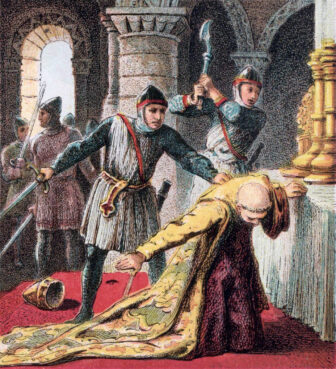LONDON (RNS) — King Henry VIII and his iconoclast-in-chief, Thomas Cromwell, would be stunned: Nearly 500 years after the English Reformation, Canterbury Cathedral, the mother church of the Protestant Church of England, will be given over to a Roman Catholic Mass, celebrated by the pope’s own representative in the country in honor of the martyr Thomas Becket, who died in the cathedral in 1170.
Not least among the historical oddities of the day will be that the Mass will award those in attendance a plenary indulgence.
When Henry broke with Rome in 1535 to create the Church of England, it led to the destruction of shrines to saints and martyrs, including their relics. The tradition of offering pilgrims an indulgence for visiting these shrines — a key driver of the Protestant revolt across Europe at the time — was ended.
But on Monday (July 7), Canterbury Cathedral will reverse that history when a Mass is celebrated by Archbishop Miguel Maury Buendia, apostolic nuncio to the United Kingdom, to mark one of the feasts of Becket, the former Archbishop of Canterbury murdered by knights acting for another English king, Henry II. After a repentant Henry II paid a public penance the following year, Becket was made a saint in 1173, and Canterbury quickly become a place of pilgrimage.
The feast, known as the translation of St. Thomas Becket, commemorates the moving of Becket’s relics from the cathedral crypt to the shrine behind the main altar, where they stayed until 1538 when, on the orders of Henry VIII who particularly wanted the cult of Becket suppressed, the crypt was destroyed.

An 1868 depiction by artist Joseph Martin Kronheim of the murder of Archbishop Thomas Becket at the Canterbury Cathedral. (Image courtesy Wikimedia/Creative Commons)
Roman Catholic Masses have been held at the Anglican cathedral since, but this is the first time a papal nuncio will have celebrated Mass there. And while the only relics left at the cathedral are some bloodstains of Becket’s, the Roman Catholic parish of St. Thomas, also in Canterbury, has acquired a relic — a bone of Becket’s, which will be taken to the cathedral for the Mass.
As 2025 was designated a Holy Year, or Jubilee, by the late Pope Francis, Catholics are able to secure an indulgence — the remission of temporal punishment due to sin — for those who are truly repentant and meet certain conditions, including going to confession and Holy Communion, praying for the pope’s intentions and visiting a pilgrimage site.
Elizabeth Forrester, who has been organizing the Canterbury Cathedral Mass on behalf of the local Catholic parish, said, “This is particularly historic, as there is evidence that there was a papal legate present when Becket’s relics were first translated to the shrine in 1220.”
The earning of indulgences is also a first. “We are able to do this because our parish has been designated a Jubilee parish for the Holy Year.”
Visiting Canterbury Cathedral to collect indulgences was the inspiration for Chaucer’s medieval comic masterpiece, “The Canterbury Tales,” which included mockery of the trade in indulgences, which at that time could be bought. The corruption surrounding this revenue stream was considered an insult to God’s name by such reformers as Martin Luther and Thomas Cranmer, Archbishop of Canterbury during the English Reformation, and did much to provoke the split with the papacy.
Now the focus of indulgences is on spiritual development, not paying your way into forgiveness and entry to heaven.
The July 7 event at Canterbury is evidence of a growing interest in shrines, saints and relics in the Church of England, often with the help of the Roman Catholic Church, which held on to relics rescued from the iconoclasts of the Reformation by recusant families and priests.
Among the Anglican cathedrals that now have relics restored to them is Hereford, which had its shrine to St. Thomas of Cantilupe, a medieval bishop of Hereford, restored in 2008 and now houses relics of the saint, loaned to Hereford by the Roman Catholic Jesuit order. Lichfield Cathedral and St. Albans Cathedral have also acquired relics.
A 1,353-year-old relic of St. Chad, the first bishop of Lichfield, was given to Lichfield Cathedral in 2022 by the Roman Catholic Cathedral of St. Chad in nearby Birmingham, and the shrine was restored almost 500 years after its destruction in 1538. An icon and a candle stand were placed in the 1980s on the site of Chad’s original shrine, and after it became a focal point of prayer and devotion, the cathedral leaders decided to restore the shrine. The relic has been placed in a specially commissioned reliquary and was installed during an ecumenical service.
The move won’t deprive Catholics of the chance for an indulgence: “If anyone makes a pilgrimage to Lichfield Cathedral to pray at the relics of St. Chad and seeks a Jubilee Year indulgence those conditions would be sufficient to gain an indulgence,” said Roman Catholic Archbishop of Birmingham Bernard Longley.
Longley said at the time of the donation of the relics that the “veneration of relics and their enclosure in the altars of Catholic churches comes from the earliest days of the church, as Christians sought to recall and celebrate the example of faith of the early martyrs. The tradition of venerating the relics of saints encourages us to reflect on their lives as signposts of faith.”
Though venerating relics has been “a source of division in our shared history,” said Longley, a shared reflection on Chad’s life may now draw Catholics and Anglicans together.
The Anglican bishop of Lichfield, Michael Ipgrave, said, “The language of relics does not come naturally to many Anglicans, and veneration of them does not usually form part of our spiritual practice; but we do use the language and practice of memory and remembering.”
Since the shrine was restored in Lichfield, visitor numbers have increased, according to a study by Wolverhampton University. In 2013 Lichfield attracted 100,000 visitors; the cathedral’s latest annual report shows that number rose to 142,000 in 2024.
In St. Albans, named after a local saint martyred by Roman occupiers in 250, the tradition of pilgrimage, first recorded 1,700 years ago, has been revived in recent years. St. Alban’s Day was marked in the city two weeks ago, on June 18, bringing thousands, including 200 Orthodox Christians, to join in a pilgrimage procession. The reenactment of Alban’s martyrdom involved 3-meter-high carnival puppets representing the saint, Roman centurions and lions. The day finished at St. Albans Cathedral with a procession to the martyr’s shrine, where prayers were said and roses were scattered.
The shrine, destroyed during the Reformation in 1539, has been restored and now contains a bone of Alban given by a Roman Catholic church in Germany. It is believed to have been given as a gift to a German cleric on pilgrimage before the Reformation.
Visitors to St. Alban’s shrine are also encouraged to stop at the shrine of another Roman martyr, St. Amphibalus, in the cathedral. William Glendinning, a spokesman for the cathedral, said: “We have seen both the amount of candles used increase, and we are beginning to have a better understanding of engagement with the shrines. It certainly seems that it has encouraged all visitors in the Cathedral to engage with the shrines: there is a curiousness that wants to be cultivated.”
The Rev. Canon Kevin Walton, the canon chancellor of St. Albans, said: “St. Alban, and with him St. Amphibalus, are very much at the heart of this place. Many people relate to the sense that Alban is a real, living presence with us, confirmed by the physicality of our two shrines and indeed the surviving relic of St. Alban.”







